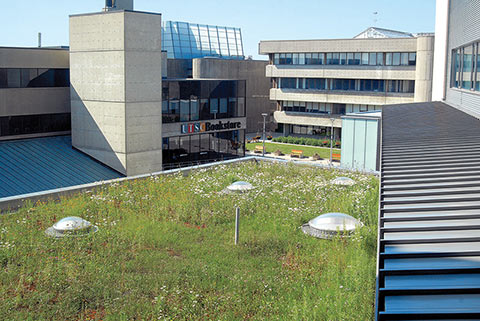Reducing greenhouse gas emissions at U of T’s three campuses is good for the environment, but it’s also a boon for academic budgets, as savings on energy bills can be applied to classrooms, labs and program improvements.
At the St. George campus, for example, a recent energy retrofit of the Medical Sciences Building has resulted in savings of more than $1 million annually in energy costs, according to Ron Swail, the chief operations officer of Property Services and Sustainability for Facilities and Services, which oversaw the project. The retrofit has also reduced annual greenhouse gas emissions by 2,327 tonnes – the equivalent of taking 1,836 cars off the roads.
Sustainable projects extend across all three campuses. At U of T Mississauga, the recent replacement of the campus’s main chiller reduced energy use by 535,000 kilowatt-hours a year, which is the average energy used by about 55 homes annually. Sixty per cent of UTM’s roofs have gardens, or are painted white to reflect sunlight. The Instructional Centre is also entirely heated and cooled by geothermal energy – heat is pumped from below the Earth’s surface to warm the building in winter, and, in summer, the centre’s heat is transferred back under the ground to cool the building. Aside from electricity to run the pumps, the centre requires no energy for heating and cooling.
U of T Scarborough’s new Toronto Pan Am Sports Centre is another sustainability gem – geothermal pipes under the parking lot provide 20 per cent of the heating and cooling for the centre. There are also more than 1,800 solar panels on the roof and rainwater cisterns for landscape irrigation.
The university has started using occupancy-sensor lights in some residences, and, on all three campuses, is switching from compact fluorescent lights, which last roughly 8,000 hours, to LEDs, which last 50,000 hours and use less than half as much electricity annually.
U of T has also installed more than 20 large rain cisterns around the St. George campus for landscaping or flushing toilets. “We have put in a very sophisticated computerized irrigation system that checks the weather, so if it rains, we won’t water the grass. That’s reduced irrigation almost by half,” says Swail. “We’ve also retrofitted and continue to retrofit washrooms with water-efficient fixtures.”
Budgetary challenges have forced the university to be more innovative and pursue energy reduction, with savings directed back to operating costs. “It’s also the right thing to do for the environment,” says Swail. Moreover, U of T follows the City of Toronto’s environmental guidelines on new buildings – “but the provincial cap and trade legislation is even more significant,” says Swail, referring to Ontario’s plan to limit greenhouse gas emissions in different sectors. U of T is expected to fall into the category of large users, which will affect how many tonnes of greenhouse gas emissions it is permitted. “I’m looking forward to the challenge,” says Swail, who is proud of U of T’s status as one of Canada’s Greenest Employers. “I know there’s more energy that we can save, and this will continue to push us forward.”
Read more about how U of T’s St. George campus is becoming “green” in the 2013-14 Sustainability Yearbook.






No Responses to “ Double Value in Being Green ”
Good to hear about U of T's conservation initiatives, including replacement of compact fluorescent lights with LEDs. But the conversion got me thinking about a possible error made by environmentalists like myself.
Compact fluorescent bulbs contain mercury. Now that we're dumping them we have an enormous disposal problem. In retrospect, perhaps we should have avoided the fluorescent lights and stayed with old incandescent bulbs until LEDs were commercially viable. It was a difficult situation because incandescent bulbs are power-hogs and their elimination was part of Ontario's strategy to end coal-fired electricity -- itself a source of mercury.
The rapid uptake of compact fluorescent bulbs offers a cautionary tale as we work to address climate change. Reducing greenhouse gases is vitally important but so is avoiding the creation of neurotoxic waste.
Gideon Forman
BA 1987 Victoria
Toronto
It is great to hear of these efforts to save on energy bills -- and wouldn’t it be nice if tuition went down as a consequence.
But even the most numerically and scientifically challenged surely know that the reduction in carbon dioxide generated from these savings will have no discernible effect whatsoever on anybody's climate. It amazes me that a world-class centre of knowledge and learning can keep on braying about this sort of environmental silliness. And what kind of unit of measurement is cars off the road, as in the claim that “the retrofit has also reduced annual greenhouse gas emissions by 2,327 tonnes – the equivalent of taking 1,836 cars off the roads”? This is a meaningless comparison since motoring around has nothing to do with energy use of buildings.
In any case, the U.S. Environmental Protection Agency’s greenhouse gas equivalencies calculator gives that amount of carbon dioxide as equivalent to 490 passenger vehicles driven for one year (obviously a gross estimate). Of course, using a car in Toronto makes little sense these days, and perhaps the extra 1,346 cars are the ones that are rarely used or will no longer be allowed to park on King's College Circle. I’m all for that!
Brian Pratt
PhD 1989
Saskatoon